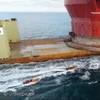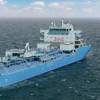Seaway Tonnage Rebounds in 2010
The St. Lawrence Seaway experienced a rebound in activity over the course of the 2010 navigation season, with a 15% increase in cargo volume yielding an estimated total of 35.5 million tonnes. Shipments of iron ore posted a strong 35% gain over the level witnessed in 2009. Grain likewise showed improvement, posting a 10% increase year over year. Coupled with a 63% surge in general cargo, which consists principally of iron and steel break-bulk shipments and project cargo such as wind turbine components, the Seaway finished the year on a positive note.
“With a recovery in the manufacturing sector, characterized by a resurgent domestic auto assembly business, the level of activity in the iron ore trade broke out of the starting gate at a brisk pace in 2010” said Terence Bowles, newly appointed President and CEO of the St. Lawrence Seaway Management Corporation (SLSMC). “It is often said that the transportation sector serves as a barometer of economic activity, and we are pleased to note that 2010 finished with positive momentum on several fronts” continued Bowles. “We are optimistic of what we may experience in 2011, as economic growth continues to regain strength”.
The Government of Canada’s decision to repeal the 25% duty on imported vessels has ushered in a new era of fleet renewal. Domestic marine carriers are gearing up to renew parts of their fleets. Algoma Central Corporation and the CSL Group have recently announced the purchase of new vessels designed for commerce within the Seaway / Great Lakes. The advent of new vessels will serve to further extend the marine mode’s advantage in energy efficiency within the transportation sector, and enhance its low carbon footprint.
With a 100% inspection rate concerning ocean vessels entering the Seaway, ballast water management has been advanced yet again in 2010. No new species attributable to ballast water carried by ocean vessels have been detected since 2006. “The application of salt water flushing is clearly having the desired impact in mitigating the introduction of new species” said Terry Johnson, Administrator of the U.S. Saint Lawrence Seaway Development Corporation. “The efficacy of salt water flushing, while not a final solution, is sufficient in scope to warrant the re-examination of ballast water management initiatives, and we are encouraged by the recent actions undertaken by the State of Wisconsin to recognize IMO standards.”
The Seaway navigation season for 2010 spanned 280 days. The St. Lawrence Seaway concluded its 2010 navigation season on December 29th with the passage of the M/V Atlantic Erie. The vessel transited the St. Lambert Lock at 11:51 a.m. on route to Montreal. The Welland Canal remained open to navigation until December 30th, as the John B. Aird transited Lock 1 at 1:00 p.m. on its way to the Port Weller dry docks.
Since its inception in 1959, over 2.5 billion tonnes valued in excess of $375 billion has been transported via the Seaway. A vital transportation artery to the heart of North America, the St. Lawrence Seaway supports tens of thousands of jobs within the mining, manufacturing and agricultural sectors.














